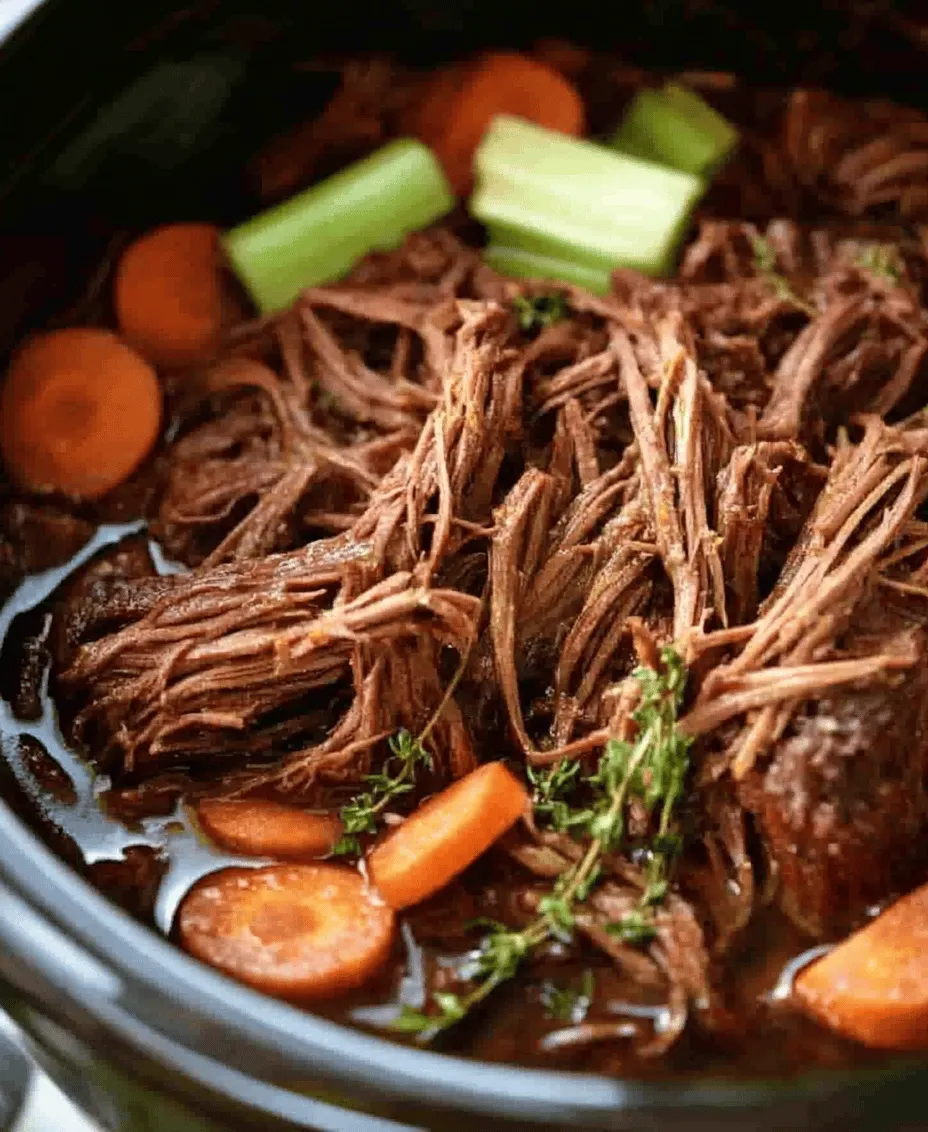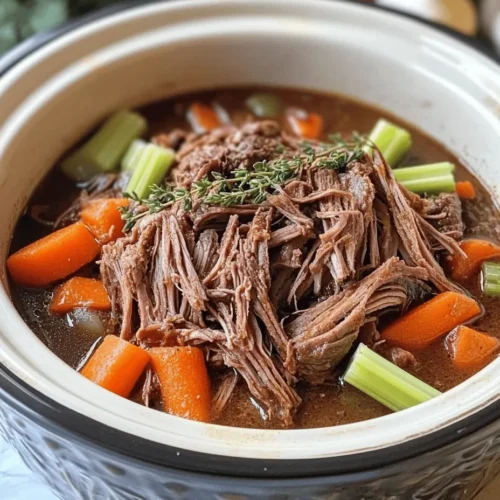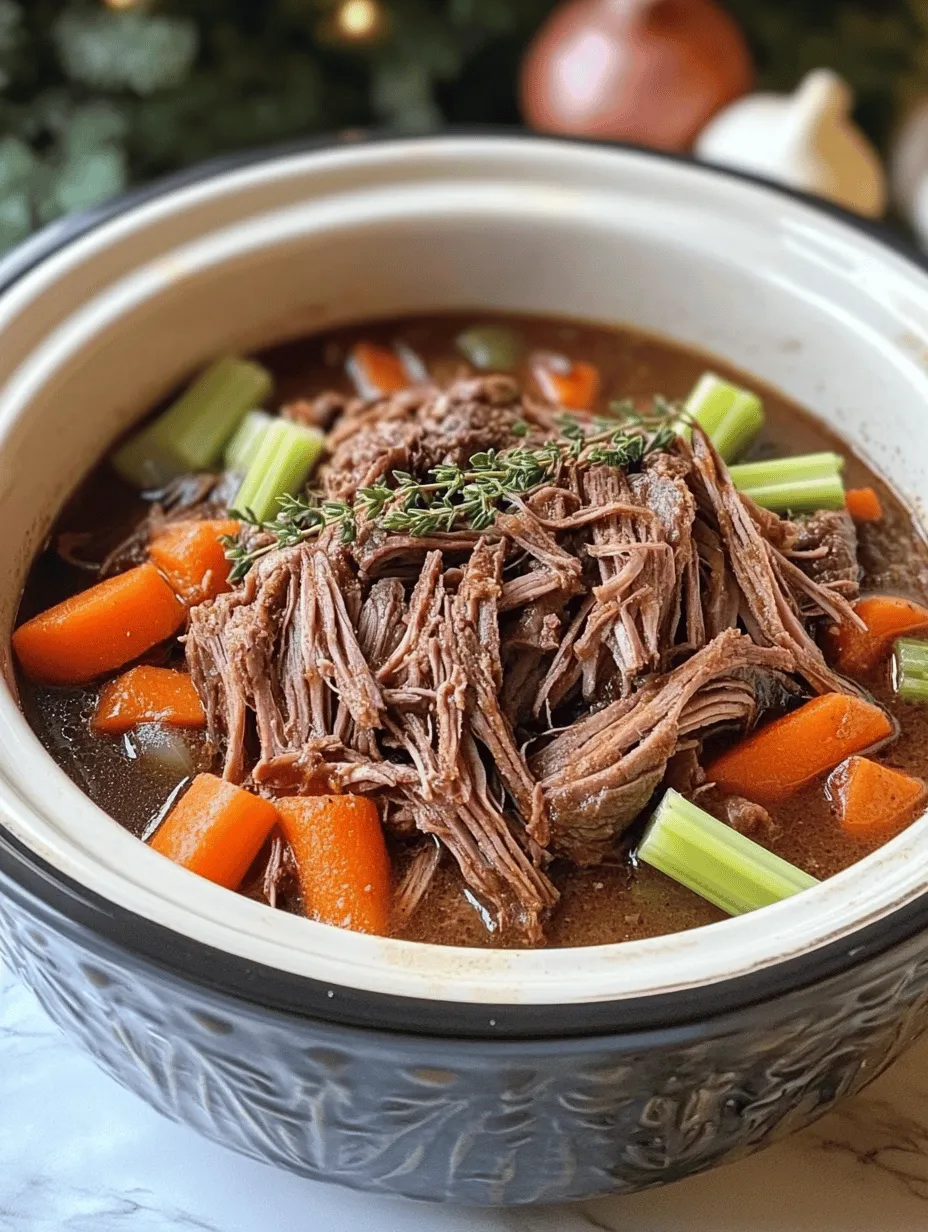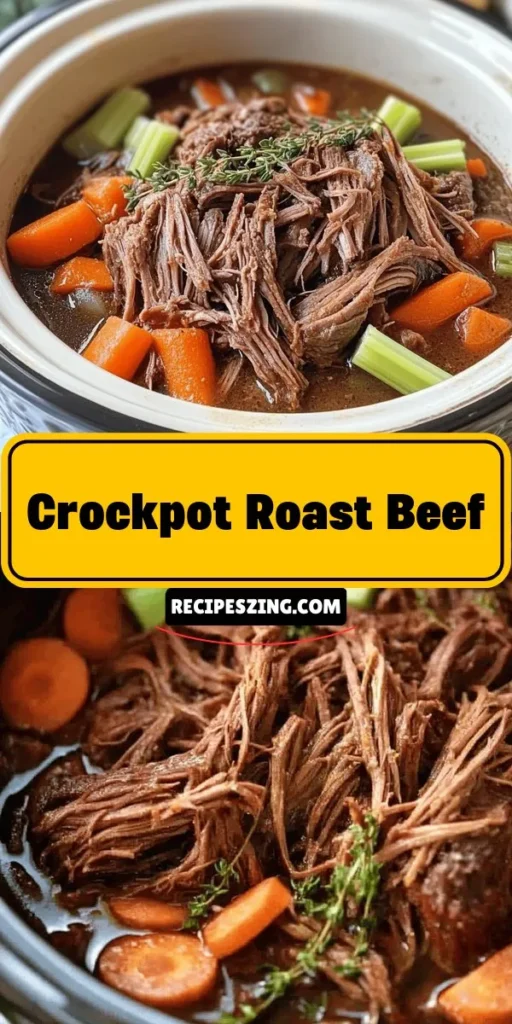Introduction
There’s something undeniably comforting about a hearty, slow-cooked meal, especially during those chilly evenings when you crave a dish that warms both body and soul. The allure of slow cooking lies not just in convenience, but in the depth of flavor that develops over hours of gentle simmering. One dish that embodies this essence is the Savory Slow-Cooked Roast Beef. This recipe promises tender, juicy beef infused with the robust flavors of aromatics, herbs, and vegetables, making it a quintessential comfort food.
As you embark on this culinary journey, you’ll discover that the key to a truly exceptional roast beef lies in using quality ingredients. A well-selected cut of beef, fresh aromatics, and a carefully chosen blend of herbs and spices can elevate your dish from ordinary to extraordinary. The combination of these elements, alongside a slow and steady cooking method, allows the flavors to meld beautifully, resulting in a meal that satisfies the heart and palate.
Understanding the Ingredients
Beef Chuck Roast
At the heart of this recipe is the beef chuck roast, a cut renowned for its rich flavor and tenderness when cooked properly. The chuck roast comes from the shoulder area of the cow, which means it has a good amount of connective tissue and marbling. These characteristics make it ideal for slow cooking, as the low and slow method melts the collagen into gelatin, resulting in a succulent, fall-apart tender roast that is bursting with flavor.
When selecting your beef chuck roast, look for one that has a good amount of marbling; this fat will render during cooking, enriching the meat with moisture and flavor. A well-marbled roast ensures that you’ll end up with a juicy, flavorful centerpiece for your meal.
Aromatics: Onion and Garlic
No savory dish is complete without the aromatic foundation of onion and garlic. These two ingredients serve as the backbone of flavor in the Savory Slow-Cooked Roast Beef recipe. Onions, when cooked, develop a natural sweetness that balances the savory notes of the beef, while garlic infuses the dish with a robust, fragrant essence.
To get the best out of these aromatics, it’s essential to sauté them properly before adding them to the slow cooker. This process enhances their flavor, releasing essential oils and sugars that will deepen the overall taste of the roast. When sautéing, aim for a golden-brown color on the onions, as this will indicate that they have caramelized sufficiently and will contribute a rich layer of sweetness to the final dish.
Vegetables: Carrots and Celery
To round out the dish, we incorporate hearty vegetables like carrots and celery. These vegetables not only add flavor but also bring nutritional benefits to the table. Carrots contribute a natural sweetness and a bright color, while celery adds a subtle earthiness and crunch. Together, they create a wonderful medley that complements the savory beef.
Beyond their taste, both carrots and celery are rich in vitamins and minerals. Carrots are an excellent source of beta-carotene, which converts to vitamin A in the body, promoting healthy vision, skin, and immune function. Celery, on the other hand, is low in calories and high in fiber, making it a great addition for those looking to maintain a balanced diet.
Broth and Wine
A crucial element in achieving a rich and flavorful roast is the use of broth and wine. The broth serves as the cooking liquid, helping to keep the beef moist and infusing the dish with additional flavor. A good quality beef broth or stock will enhance the beefy taste, while also acting as a base for the sauce that will develop during cooking.
Wine, particularly red wine, is often added to bring acidity and complexity to the dish. The alcohol cooks off during the slow-cooking process, leaving behind a depth of flavor that enhances the overall profile of the roast. However, if you prefer not to use wine, there are excellent alternatives available, such as additional beef broth or a splash of balsamic vinegar, which can mimic the acidity and richness without the alcohol.
Herbs and Spices: Thyme, Rosemary, Salt, and Pepper
To finish off our ingredient lineup, we turn to herbs and spices. Thyme and rosemary are the stars of this dish, providing an aromatic quality that perfectly complements the beef. These herbs not only add fragrance but also enhance the savory notes of the roast. Fresh herbs are always preferable, but if dried herbs are what you have on hand, they can also work well—just remember that dried herbs are typically more potent, so adjust the quantity accordingly.
Salt and pepper are essential for seasoning and should be used generously to enhance the flavors of all the ingredients. Proper seasoning is key to ensuring that your roast beef is flavorful throughout, so don’t skimp on these important components.
Preparation Steps Explained
With a solid understanding of the ingredients, it’s time to delve into the preparation steps for the Savory Slow-Cooked Roast Beef. Each step plays a vital role in building flavor and ensuring that your roast turns out perfectly tender and delicious.
Searing the Beef
One of the most critical steps in preparing your roast beef is the searing process. While it may seem like an extra step, browning the meat before slow cooking is essential for developing a rich, deep flavor. The process of searing creates a Maillard reaction, a chemical reaction that occurs when proteins and sugars in the meat are exposed to high heat. This reaction produces a complex flavor profile and a beautifully caramelized crust on the outside of the meat.
To achieve the best sear, start by patting your beef chuck roast dry with paper towels. Removing excess moisture will help create a better crust. Next, season the meat generously with salt and pepper. Heat a large skillet or Dutch oven over medium-high heat and add a tablespoon of oil with a high smoke point, such as vegetable or canola oil. Once the oil is shimmering, carefully place the roast in the skillet.
Allow the roast to sear undisturbed for about 4-5 minutes on each side, or until it develops a deep brown crust. Avoid overcrowding the pan, as this can cause the meat to steam rather than sear. Once browned on all sides, remove the roast from the skillet and set it aside. This step not only enhances the flavor of the beef but also provides a base for the fond—the flavorful brown bits left in the pan that can be deglazed to create a sauce later.
Sautéing Aromatics
Next, it’s time to sauté the onions and garlic, which will add an incredible depth of flavor to your roast. Using the same skillet with the fond from the seared beef, add a little more oil if needed and lower the heat to medium. Start by adding chopped onions to the pan. Stir occasionally, allowing the onions to soften and become translucent. This should take about 5-7 minutes.
Once the onions are softened, add minced garlic and continue sautéing for an additional 1-2 minutes. Keep a close eye on the garlic, as it can burn quickly and become bitter. You want the garlic to be fragrant and lightly golden, which will enhance the overall sweetness and aroma of the dish.
After the onions and garlic have been sautéed to perfection, it’s time to transfer everything to your slow cooker. This aromatic mixture will serve as a flavorful foundation for your roast beef, allowing the flavors to meld beautifully as it cooks.
By focusing on the quality of your ingredients and the preparation methods, you’re setting the stage for a mouthwatering Savory Slow-Cooked Roast Beef that will impress family and friends alike. Each step builds upon the last, ensuring that every bite is rich in flavor and satisfying. As we continue to explore this recipe, you’ll see how simple ingredients and techniques can come together to create a truly unforgettable dish.

Combining Ingredients: Achieving Balance in Flavors
Creating a savory slow-cooked roast beef begins with the careful selection and combination of ingredients. The key to a successful dish lies in balancing flavors. Start by seasoning your beef with salt and pepper to enhance its natural taste. You can enhance the flavor profile further by adding garlic powder, onion powder, and dried herbs like thyme, rosemary, and oregano. These spices not only season the meat but also infuse it with depth during the slow cooking process.
When combining your ingredients, think about the harmony of flavors. For instance, a splash of balsamic vinegar or a few tablespoons of Worcestershire sauce can introduce a tangy richness that balances the savory components. Mixing in a bit of brown sugar can also work wonders, counteracting the acidity and creating a beautifully caramelized crust on the meat as it cooks.
Importance of Layering Flavors for a Deep, Savory Taste
Layering flavors is crucial for a dish like roast beef, where the cooking method allows the ingredients to meld and develop over time. Start by searing the beef in a hot pan before transferring it to the slow cooker or oven. This initial step caramelizes the surface, creating a complex flavor that will enrich the final dish.
While the beef rests, sauté your aromatics—such as onions, carrots, and celery—in the same pan. This technique allows you to capture the fond (the caramelized bits stuck to the pan) and incorporate it into your dish. Adding these sautéed vegetables to your slow cooker or roasting pan provides an additional layer of flavor that enhances the meat’s taste.
Adding Vegetables: Placement and Seasoning Tips
Vegetables not only add flavor but also moisture and nutrients to your roast beef. When adding vegetables to your dish, consider their cooking times. Root vegetables like carrots, potatoes, and parsnips can withstand long cooking times, making them perfect companions for your roast. Place these heartier vegetables at the bottom of the slow cooker or roasting pan; they will absorb the juices released by the meat, enhancing their flavor.
For quicker-cooking vegetables like bell peppers or zucchini, add them halfway through the cooking process to ensure they don’t become mushy. Season the vegetables with salt, pepper, and a drizzle of olive oil to bring out their natural sweetness. Additionally, tossing them in the same herbs used for the meat will create a cohesive and well-rounded flavor.
How to Ensure Even Cooking and Flavor Distribution
To achieve even cooking and optimal flavor distribution, it’s essential to arrange your ingredients thoughtfully. Make sure the roast is centered in the cooker or pan, surrounded by vegetables. This placement allows the heat and juices to circulate evenly, ensuring that every bite is juicy and flavorful.
If you’re using a slow cooker, it’s crucial to avoid overloading it. Too much food can trap steam and prevent the roast from browning properly. For the best results, fill the slow cooker to about two-thirds full. If you’re using a traditional oven, consider covering the roast with foil for the first half of the cooking time, then removing it to allow the surface to brown.
Cooking Methods: Slow Cooker vs. Traditional Oven
When it comes to cooking methods, both the slow cooker and traditional oven have their advantages. The slow cooker is perfect for those busy days when you want to set it and forget it. This method allows the beef to cook low and slow, which results in a tender, fall-apart roast that’s infused with all the flavors of the seasonings and vegetables.
Conversely, a traditional oven may offer a different texture and flavor profile. Cooking at a higher temperature can create a beautiful crust on the outside while keeping the inside juicy. Depending on your preference, you might choose to sear the beef on the stovetop and then transfer it to the oven to finish cooking.
Advantages of Slow Cooking for Busy Lifestyles
The slow cooker is an ideal tool for those with busy lifestyles. With minimal preparation, you can place your ingredients in the cooker in the morning and return home to a delicious meal ready to serve. Furthermore, slow cooking allows for better flavor development, as the extended time helps the spices and herbs integrate into the meat.
In addition to convenience, using a slow cooker can often be more energy-efficient than a traditional oven, making it a practical choice for everyday cooking. Plus, you can easily adjust the heat setting based on your schedule—low for 8 hours, or high for 4 hours, depending on your time constraints.
Tips for Adjusting Cooking Times and Methods Based on Equipment
When adjusting cooking times and methods based on your equipment, it’s essential to consider the size and type of your roast. A larger cut will require more time, while smaller cuts may cook more quickly. As a general guideline, plan for about 20 minutes of cooking time per pound for a traditional oven roast at 325°F (163°C) and about 8 hours on low or 4 hours on high for a slow cooker.
Always use a meat thermometer to check for doneness. The USDA recommends a minimum internal temperature of 145°F (63°C) for beef. However, for roast beef that you want to be fork-tender, aim for a temperature of about 190°F (88°C).
Discussion of Temperature Settings and Their Impact on the Final Dish
The temperature setting you choose can significantly impact the final dish’s texture and flavor. When cooking in a slow cooker, the low setting allows the collagen in the meat to break down slowly, resulting in a tender roast. The high setting, while quicker, may not yield the same level of tenderness.
In the oven, cooking at a lower temperature (around 300°F or 149°C) will produce a more evenly cooked roast. However, higher temperatures (375°F or 190°C) can create a delicious crust and enhance flavor through caramelization. Experiment with different temperatures to see which method you prefer based on your taste and time constraints.
Serving Suggestions
Once your savory slow-cooked roast beef is ready, it’s time to serve it up! This dish pairs beautifully with a variety of sides. Classic accompaniments include creamy mashed potatoes, which can soak up the rich gravy created during cooking, or crusty bread to mop up every last bit of juice. Roasted vegetables, such as Brussels sprouts or green beans, not only complement the beef but also add color and nutritional value to your meal.
For a more elegant presentation, slice the roast thinly against the grain and arrange it on a platter. Drizzle some of the cooking juices over the top and garnish with fresh herbs for a pop of color. A side salad can also add freshness to the meal, balancing the richness of the roast.
Suggestions for Storing Leftovers and Reheating Techniques
If you find yourself with leftovers—a common occurrence with such a hearty dish—proper storage is vital. Allow the roast to cool down before wrapping it tightly in plastic wrap or transferring it to an airtight container. Leftover roast beef can be stored in the refrigerator for up to four days or frozen for up to three months.
When it comes to reheating, avoid the microwave if possible, as it can dry out the meat. Instead, wrap the slices in aluminum foil and place them in a preheated oven at 300°F (149°C) until warmed through. You can also add a splash of beef broth or some of the reserved cooking juices to help maintain moisture.
Nutritional Information
Savory slow-cooked roast beef not only satisfies the taste buds but also provides valuable nutrition. A serving of roast beef is an excellent source of protein, offering approximately 25-30 grams per serving. The vegetables you include add essential vitamins and minerals, such as Vitamin A from carrots and Vitamin C from bell peppers.
The nutritional content can vary depending on the specific ingredients and cooking methods used, but a standard serving of roast beef with vegetables can contain around 350-450 calories. When considering portion sizes, aim for a balanced plate that includes protein, vegetables, and a carbohydrate source like potatoes or bread to create a satisfying meal.
Conclusion
In summary, preparing a savory slow-cooked roast beef is not only simple but also immensely satisfying. The process allows for creativity in combining flavors, layering ingredients, and adjusting cooking methods to fit your lifestyle. This recipe is versatile enough to serve as a comforting family meal or a centerpiece for gatherings, inviting everyone to enjoy a hearty dish together.
Encouraging experimentation with variations—whether it’s different seasonings, vegetables, or cooking methods—can elevate your cooking experience. Embrace the process, savor the aromas wafting through your kitchen, and enjoy the delicious results of your efforts with family and friends.



